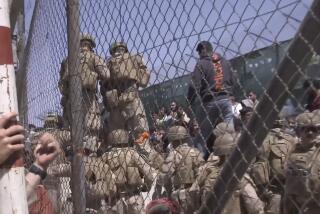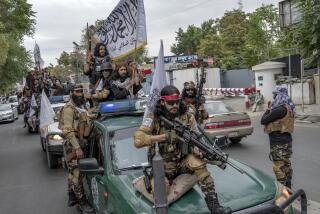5 U.S. troops killed, 2 missing in Afghanistan
Reporting from Kabul, Afghanistan — By any measure, Saturday was a very bad day in Afghanistan for U.S. forces: a convergence of two dreaded battlefield events.
Two U.S. soldiers were missing and feared captured or killed by the Taliban, military and Afghan officials said. And five other U.S. service members were killed by improvised explosive devices, which now pose a greater threat to life and limb for Western troops than at any point in the nine-year war.
Details of what exactly had befallen the two missing men were murky. The NATO force said in a statement that they had left their base Friday and had not been heard from since. A search was underway, it said.
Hours before that announcement, the Taliban claimed its fighters were holding two Westerners in Lowgar province, close to the capital, Kabul. An Afghan official in Lowgar, provincial spokesman Din Mohammad Darwesh, said it was believed that one of the men was being held prisoner and the second had been killed, under circumstances that were not yet clear.
The two were last seen at a bazaar in Lowgar’s Charkh district, Darwesh said. NATO was unable to provide any information about their mission, and two Western military officials, both speaking on condition of anonymity, raised the possibility that the two had set off without orders.
Until now, only one U.S. soldier has been known to be held captive by the Taliban: Pfc. Bowe Bergdahl, who was seized outside a base in eastern Afghanistan nearly 13 months ago. The insurgents have released videos of the Idaho native pleading for his release and calling on foreign forces to leave Afghanistan.
The capture of any Western military personnel by the Taliban is a demoralizing blow for NATO forces. It provides the insurgents with a propaganda coup and a bargaining chip, and is guaranteed to be an ordeal for the captive’s loved ones.
Amid anxiety Saturday over the fate of the missing men, the increase in deaths continued from roadside bombs — a misnomer, because the crude but lethal weapons can be hidden almost anywhere. Four of the five deaths came in a single blast.
The Pentagon has made a major push this year to reduce such casualties with better technology, more intensive training and what military officials describe as greater cooperation from Afghan villagers in pointing out where bombs are buried.
Although dozens and sometimes hundreds of devices are found and defused each week, hidden bombs remain a scourge, maiming and killing Western troops and Afghan civilians alike on a near-daily basis.
Multiple troop deaths in a single incident are becoming increasingly common, as insurgents plant larger numbers of bombs, and as the explosive payloads of these weapons increase.
Armored vehicles, particularly newer models, provide soldiers with some protection, but they can also be a deathtrap. When a cluster of troops is killed, it is almost always because they were riding together in a vehicle that hit a large bomb.
Troops patrolling on foot, by contrast, try to keep enough distance between them so that if one of them is unlucky enough to trigger an IED, his comrades might be injured, but survive.
The U.S. military has made counter-IED measures a priority, and is sharing know-how and equipment with coalition allies. Senior military officials said this month that $3 billion in counter-IED equipment, including more sophisticated surveillance drones and blimps, was en route to Afghanistan.
IED “forensics” is becoming a more sophisticated endeavor as well, with an influx of hundreds of specialized investigators and lab technicians. And on almost any given day or night, Western and Afghan troops carry out raids on bomb-making rings.
On Saturday, for example, the military said Western and Afghan forces had staged an overnight raid aimed at an important IED facilitator in the Haqqani network, a feared insurgent faction. Several suspects were detained and two reported killed in the strike in Khowst province, near the Pakistani border.
NATO’s International Security Assistance Force, which announced the latest IED deaths, did not specify where they occurred, other than to say that all took place in the south. U.S. troops are heavily concentrated in the provinces of Helmand and Kandahar, longtime Taliban strongholds.
Both provinces have been the focus of large-scale military efforts this year. A long-delayed operation in and around Kandahar city, the urban hub of the south, is finally gathering momentum, with a significant offensive looming in the outlying district of Arghandab.
In announcing Saturday’s fatalities, the North Atlantic Treaty Organization force did not release the nationalities of the victims, but U.S. officials confirmed all five were Americans.
Monthly U.S. troop deaths have reached their highest levels of the war. Last month a record 60 Americans were killed in Afghanistan; the most recent fatalities bring the tally for July to 57, according to icasualties.org, an independent website.
U.S. military officials attribute the rising casualty figures to a nearly completed troop increase that has brought U.S. levels in the country to nearly 100,000, and to the fact that the arriving forces are pushing into insurgent-controlled areas.
The Taliban boasts, however, that the Western military, for all its power and prowess, will always be vulnerable to IEDs, sniper fire and small-scale ambushes — the hallmarks of asymmetrical warfare.
More to Read
Sign up for Essential California
The most important California stories and recommendations in your inbox every morning.
You may occasionally receive promotional content from the Los Angeles Times.









